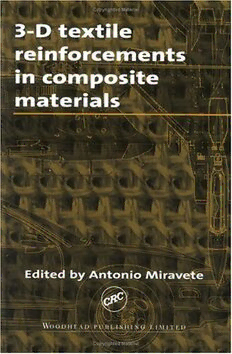
3-D Textile Reinforcements In Composite Materials (1999) PDF
323 Pages·1999·4.644 MB·English
Most books are stored in the elastic cloud where traffic is expensive. For this reason, we have a limit on daily download.
Preview 3-D Textile Reinforcements In Composite Materials (1999)
Description:
Laminated composite materials have been used in structural applications since the 1960s. However, their high cost and inability to accommodate fibers in the laminate's thickness direction greatly reduce their damage tolerance and impact resistance. The second generation of materials-3-D textile reinforced composites-offers significant cost reduction, and by incorporating reinforcement in the thickness direction, dramatically increases damage tolerance and impact resistance.However, methods for predicting mechanical properties of 3-D textile reinforced composite materials tend to be more complex. These materials also have disadvantages-particularly in regard to crimps in the yarns-that require more research. Textile preforms, micro- and macromechanical modeling, manufacturing processes, and characterization all need further development. As researchers overcome these problems, this new generation of composites will emerge as a highly competitive family of materials.3-D Textile Reinforcements in Composite Materials provides a state-of-the-art account of this promising technology. In it, top experts describe the manufacturing processes, highlight the advantages, identify the main applications, analyze methods for predicting mechanical properties, and detail various reinforcement strategies, including grid structure, knitted fabric composites, and the braiding technique.Armed with the information in this book, readers will be prepared to better exploit the advantages of 3-D textile reinforced composites, overcome its disadvantages, and contribute to the further development of the technology.
See more
The list of books you might like
Most books are stored in the elastic cloud where traffic is expensive. For this reason, we have a limit on daily download.
